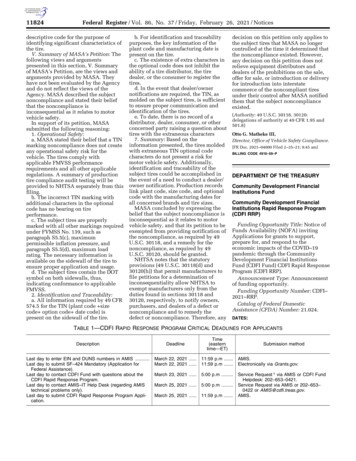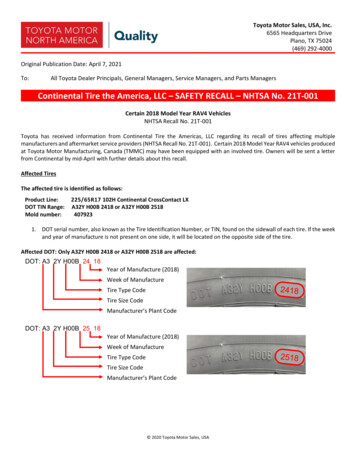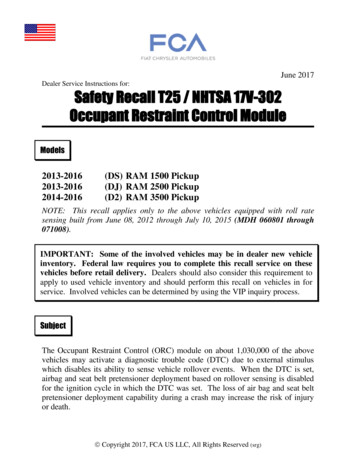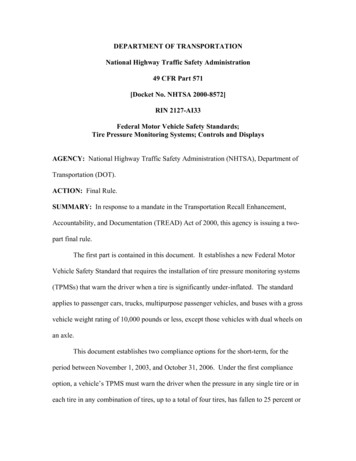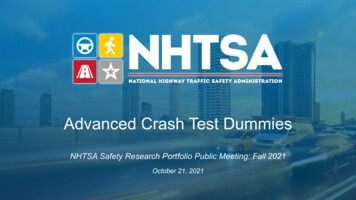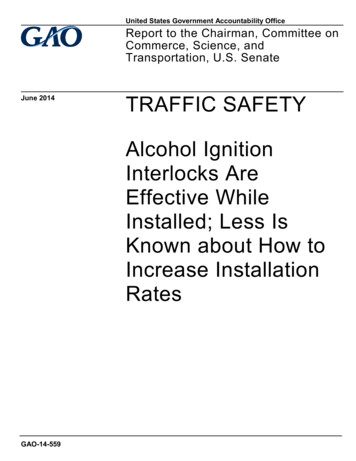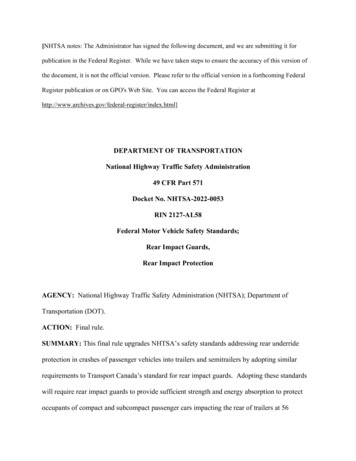
Transcription
[NHTSA notes: The Administrator has signed the following document, and we are submitting it forpublication in the Federal Register. While we have taken steps to ensure the accuracy of this version ofthe document, it is not the official version. Please refer to the official version in a forthcoming FederalRegister publication or on GPO's Web Site. You can access the Federal Register tml]DEPARTMENT OF TRANSPORTATIONNational Highway Traffic Safety Administration49 CFR Part 571Docket No. NHTSA-2022-0053RIN 2127-AL58Federal Motor Vehicle Safety Standards;Rear Impact Guards,Rear Impact ProtectionAGENCY: National Highway Traffic Safety Administration (NHTSA); Department ofTransportation (DOT).ACTION: Final rule.SUMMARY: This final rule upgrades NHTSA’s safety standards addressing rear underrideprotection in crashes of passenger vehicles into trailers and semitrailers by adopting similarrequirements to Transport Canada’s standard for rear impact guards. Adopting these standardswill require rear impact guards to provide sufficient strength and energy absorption to protectoccupants of compact and subcompact passenger cars impacting the rear of trailers at 56
2kilometers per hour (km/h) (35 miles per hour (mph)). Upgraded protection will be provided incrashes in which the passenger motor vehicle hits: (a) the center of the rear of the trailer orsemitrailer; and, (b) in which 50 percent of the width of the passenger motor vehicle overlaps therear of the trailer or semitrailer. This rulemaking commenced in response to petitions forrulemaking from the Insurance Institute for Highway Safety (IIHS) and from Ms. MarianneKarth and the Truck Safety Coalition (TSC). This final rule responds to and fulfills therulemaking mandate of Section 23011(b)(1)(A) of the November 2021 Bipartisan InfrastructureLaw (BIL) that directs the Secretary to upgrade current Federal safety standards for rear impactguards. NHTSA is also issuing this final rule pursuant to DOT’s January 2022 NationalRoadway Safety Strategy, which describes the five key objectives of the Department’s SafeSystem Approach: safer people, safer roads, safer vehicles, safer speeds, and post-crash care.One of the key Departmental actions to enable safer vehicles is to issue a final rule to upgradeexisting requirements for rear impact guards on newly manufactured trailers and semitrailers.DATES: Effective Date: This final rule is effective on [INSERT DATE 180 DAYS AFTERDATE OF PUBLICATION OF THIS FINAL RULE IN THE FEDERAL REGISTER].Compliance Date: [INSERT DATE TWO YEARS AFTER DATE OFPUBLICATION OF THIS FINAL RULE IN THE FEDERAL REGISTER]. Optional earlycompliance is permitted.Petitions for Reconsideration: Petitions for reconsideration of this final rule must bereceived no later than [INSERT DATE 45 DAYS AFTER DATE OF PUBLICATION INTHE FEDERAL REGISTER].ADDRESSES: Petitions for reconsideration of this final rule must refer to the docket and noticenumber set forth above and be submitted to the Administrator, National Highway Traffic Safety
3Administration, 1200 New Jersey Avenue SE, West Building, Washington, DC 20590. Allpetitions received will be posted without change to http://www.regulations.gov, including anypersonal information provided.Privacy Act: DOT will post any petition for reconsideration, and any other submission,without edit, to www.regulations.gov, as described in the system of records notice, DOT/ALL-14FDMS, accessible through /privacy-actsystem-records-notices. Anyone is able to search the electronic form of all submissions to any ofour dockets by the name of the individual submitting the submission (or signing the comment, ifsubmitted on behalf of an association, business, labor union, etc.). You may review DOT'scomplete Privacy Act Statement in the Federal Register published on April 11, 2000 (Volume65, Number 70; Pages 19477-78).FOR FURTHER INFORMATION, CONTACT:For technical issues: Ms. Lina Valivullah, National Highway Traffic SafetyAdministration, 1200 New Jersey Avenue SE, West Building, Washington, DC 20590(telephone) 202-366-8786, (email) Lina.Valivullah@dot.gov.For legal issues: Ms. Deirdre Fujita, Office of the Chief Counsel, National HighwayTraffic Safety Administration, 1200 New Jersey Avenue SE, West Building, Washington, DC20590, (telephone) 202-366-2992, (email) Dee.Fujita@dot.gov.SUPPLEMENTARY INFORMATION:Table of ContentsI.Executive Summarya. Overviewb. NHTSA’s Statutory Authority and Response to BIL1. National Traffic and Motor Vehicle Safety Act2. Bipartisan Infrastructure Law3. Implementation of BIL
4c.d.e.f.DOT National Roadway Safety StrategyNTSB RecommendationImpacts of this RulemakingNo Significant Changes to the NPRMII.Backgrounda. Current Requirementsb. Petitionsc. Summary of Proposed ChangesIII.Summary of CommentsIV.Response to Comments on the Proposed Amendmentsa. General Strength and Energy Absorption Requirementsb. Alternative Guard Designsc. 700 kN Energy Absorption Test Optiond. Ground Clearancee. Requiring Attachment Hardware to Remain Intactf. Definition of Rear Extremityg. Low Chassis Vehicle Correctionh. Technical CorrectionV.Response to Comments on Issues Not Proposed in the NPRMa. Vehicles Excluded from FMVSS No. 224b. Testing on a Trailer Rather Than a Fixturec. Low Overlap Crash Performanced. Half-Guard Testinge. RetrofittingVI.Lead TimeVII.Benefit-Cost AnalysisVIII. Regulatory Notices and AnalysesI.Executive Summarya. OverviewNHTSA is issuing this final rule to upgrade Federal Motor Vehicle Safety Standard(FMVSS) No. 223, “Rear impact guards,” and FMVSS No. 224, “Rear impact protection,”which together provide protection for occupants of passenger vehicles in crashes into the rear of
5trailers and semitrailers. FMVSS No. 223, an equipment standard, specifies strength and energyabsorption requirements in quasi-static force tests of rear impact guards sold for installation onnew trailers and semitrailers. FMVSS No. 224, a vehicle standard, requires new trailers andsemitrailers with a gross vehicle weight rating (GVWR) of 4,536 kilogram (kg) (10,000 pounds(lb)) or more to be equipped with a rear impact guard meeting FMVSS No. 223.1 The notice ofproposed rulemaking (NPRM) preceding this final rule was published on December 16, 2015.2Rear underride crashes occur when a passenger vehicle crashes into the rear end of agenerally larger vehicle, and the front end of the passenger vehicle slides under (i.e., underrides)the rear end of the larger vehicle. Underride may occur in collisions between a passenger vehicleand the rear end of a large trailer or semitrailer (referred to in this rule collectively as “trailers”)because the bed and chassis of the trailer is often higher than the front of the passenger vehicle.In extreme underride crashes, “passenger compartment intrusion” (PCI) may occur when thepassenger vehicle underrides the rear end of the trailer to such an extent that the rear end of thetrailer strikes and enters the passenger compartment of the colliding passenger vehicle. PCI canresult in severe injuries and fatalities to the occupants of the passenger vehicle.Rear impact guards are mounted on the rear of trailers to prevent underride and PCI. In acollision between a passenger vehicle and the rear of a trailer equipped with a rear impact guard,the rear impact guard engages the striking passenger vehicle and prevents it from sliding too farunder the struck vehicle’s bed and chassis. FMVSS Nos. 223 and 224 ensure a rear impact guard1NHTSA established the two-standard approach to address compliance burdens on small trailer manufacturers, ofwhich there is a significant number. Under FMVSS No. 223, the guard may be tested for compliance whilemounted to a test fixture or to a complete trailer, at the manufacturer’s option. FMVSS No. 224 requires the guardto be mounted on the trailer or semitrailer in accordance with the instructions provided with the guard by the guardmanufacturer. Under this two-standard approach, a small manufacturer that produces relatively few trailers cancertify its trailers to FMVSS No. 224 with assurance without having to undertake destructive testing of what couldbe a substantial portion of its production. The two-standard approach was designed to provide small trailermanufacturers a practicable and reasonable means of certifying to FMVSS No. 224.280 FR 78417.
6is configured low and wide to impede a striking passenger vehicle, is strong enough to withstanda 48 km/h (30 mph) impact of the colliding vehicle, and has energy-absorbing capability tofurther mitigate harm to occupants in the striking vehicle.NHTSA designed FMVSS No. 223 and 224 to work in conjunction with FMVSS No.208, “Occupant crash protection,” so that occupants are protected with seat belts and air bags inthe underride crash - thus maximizing the likelihood of avoiding serious or fatal injury in theimpact into the guard. When FMVSS Nos. 223 and 224 were issued in 1996, FMVSS No. 208required passenger cars to provide crash protection in a 48 km/h (30 mph) rigid barrier crash test.The agency designed the underride protection standards so that occupants would be reasonablyprotected in underride crashes up to 48 km/h (30 mph). Since then, FMVSS No. 208’s test speedhas been increased to provide high levels of occupant protection in a 56 km/h (35 mph) frontalcrash.With FMVSS No. 208 now providing crash protection up to 56 km/h (35 mph), NHTSAis amending FMVSS Nos. 223 and 224 to mandate the guards withstand crash velocities up tothat speed. This final rule adopts requirements of Canada Motor Vehicle Safety Standard(CMVSS) No. 223, “Rear impact guards.”3 CMVSS No. 223 requires rear impact guards withsufficient strength and energy absorption capability to protect occupants of compact andsubcompact passenger cars impacting the rear of trailers at 56 km/h (35 mph). Under this finalrule, the impacting vehicle’s FMVSS No. 208 occupant protection technologies could absorbenough of the crash forces from the impact to reduce significantly the risk of fatality and seriousinjury to occupants of the colliding vehicle. As the current requirements in FMVSS Nos. 223and 224 were developed with the intent of providing underride crash protection to occupants of3This final rule also adopts Transport Canada’s definition of “rear extremity” to define where aerodynamic fairingsare to be located on a trailer to avoid posing a safety hazard in rear underride crashes.
7passenger vehicles in impacts up to 48 km/h (30 mph), increasing the robustness of thetrailer/guard design such that it will be able to withstand crash velocities up to 56 km/h (35 mph)represents a substantial increase in the stringency of our standards. There is a 36 percentincrease in crash energy in a 56 km/h (35 mph) impact of a vehicle compared to a 48 km/h (30mph) impact of the same vehicle.This final rule is based on the best available science. The underlying field data used inthe December 16, 2015 NPRM and this final rule are from a 2013 NHTSA-funded studyconducted by the University of Michigan Transportation Research Institute (UMTRI) tosupplement UMTRI’s Trucks Involved in Fatal Accidents (TIFA) survey data for years 2008 and2009. (The 2013 NHTSA-funded study is referred to in this preamble as the 2013 UMTRIStudy.)4, 5 The TIFA database had analyzed FARS data to obtain more detailed information onfatal large truck crashes, and had provided more detailed information than in FARS on theinvolved large trucks, motor carriers, and sequence of events leading to the crash.6 The 2013UMTRI Study supplemented these TIFA data by collecting specific data pertaining to trailer rearextremity crashes. In the 2013 UMTRI Study, UMTRI also determined whether a rear impactguard was required, and if not required, the criterion that had excluded the vehicle. The 2013UMTRI Study collected detailed information on fatal vehicle crashes into the rear of trailers, therelative impact velocity, and the extent of underride in these crashes. The data from the 2013UMTRI Study enabled NHTSA to establish national estimates of rear impact crashes into heavyvehicles that resulted in PCI. Because of the detailed analysis and the supplemental information4NHTSA discussed the results of this study in detail in Appendix A of the NPRM. See 80 FR 78447-78452.Heavy-Vehicle Crash Data Collection and Analysis to Characterize Rear and Side Underride and Front Override inFatal Truck Crashes, DOT HS 811 725, March 2013, .pdf.6The TIFA survey data contain data for all trucks with a GVWR greater than 4,536 kg (10,000 lb) that wereinvolved in fatal traffic crashes in the 50 U.S. States and the District of Columbia.5
8collected for each crash, the 2013 UMTRI Study forms the most comprehensive and valid dataset available to inform NHTSA about crashes involving trucks and trailers and the incidence andextent of underride.b.NHTSA’s Statutory Authority and Response to BIL1. National Traffic and Motor Vehicle Safety ActThis final rule is issued under the National Traffic and Motor Vehicle Safety Act (SafetyAct) (49 U.S.C. 30101 et seq.). Under the Safety Act, the Secretary of Transportation (NHTSAby delegation)7 is responsible for prescribing motor vehicle safety standards that are practicable,meet the need for motor vehicle safety, and are stated in objective terms.8 “Motor vehiclesafety” is defined in the Safety Act as “the performance of a motor vehicle or motor vehicleequipment in a way that protects the public against unreasonable risk of accidents occurringbecause of the design, construction, or performance of a motor vehicle, and against unreasonablerisk of death or injury in an accident, and includes nonoperational safety of a motor vehicle.”9“Motor vehicle safety standard” means a minimum performance standard for motor vehicles ormotor vehicle equipment.10 When prescribing such standards, the agency must consider allrelevant, available motor vehicle safety information, and consider whether a standard isreasonable, practicable, and appropriate for the types of motor vehicles or motor vehicle749 CFR 1.95. The Secretary also delegated to NHTSA the authority set out for Section 101(f) of Public Law 106159 to carry out, in coordination with the Federal Motor Carrier Safety Administrator, the authority vested in theSecretary by subchapter 311 and section 31502 of title 49, U.S.C., to promulgate safety standards for commercialmotor vehicles and equipment subsequent to initial manufacture when the standards are based upon and similar to aFederal Motor Vehicle Safety Standard promulgated, either simultaneously or previously, under chapter 301 of title49, U.S.C.849 U.S.C. § 30111(a).949 U.S.C. § 30102(a)(8).1049 U.S.C. §30102(a)(9).
9equipment for which it is prescribed.11 The agency must also consider the extent to which thestandard will further the statutory purpose of reducing traffic crashes and associated deaths.122. Bipartisan Infrastructure LawOn November 15, 2021, President Biden signed the Infrastructure Investment and JobsAct (IIJA),13 commonly referred to as the Bipartisan Infrastructure Law (BIL). Section 23011 ofBIL specifies provisions for underride protection measures for trailers and semitrailers. Asdiscussed in detail below, the provisions direct the Secretary to upgrade current Federal safetystandards for rear impact guards and conduct additional research, report to Congress on theeffectiveness, feasibility, costs, and benefits of side guards, establish an advisory committee onunderride protection, and implement the recommendations issued by the GovernmentAccountability Office (GAO) on improved data collection, inspection and research of truckunderride guards.Section 23011(b)(1)(A) of BIL states that, not later than 1 year after the date ofenactment of the Act, the Secretary shall promulgate regulations that revise FMVSS No. 223 andFMVSS No. 224 to require new trailers and semitrailers to be equipped with rear impact guardsthat are designed to prevent PCI from a trailer or semitrailer when a passenger vehicle travelingat 56 km/h (35 mph) makes an impact: (a) “in which the passenger motor vehicle impacts thecenter of the rear of the trailer or semitrailer” (full overlap with the rear of the trailer orsemitrailer); (b) “in which 50 percent of the width of the passenger motor vehicle overlaps therear of the trailer or semitrailer”; and (c) “in which 30 percent of the width of the passengermotor vehicle overlaps the rear of the trailer or semitrailer, if the Secretary determines that a1149 U.S.C. § 30111(b).Id.13Pub. L. 117-5812
10revision of [FMVSS Nos. 223 and 224] to address such an impact would meet the requirementsand considerations described in subsections (a) and (b) of section 30111 of title 49, United StatesCode” (i.e., the Safety Act). Section 23011(b)(1)(B) states that the regulations promulgatedunder Section 23011(b)(1)(A) shall require full compliance not later than two years after the dateon which those regulations are promulgated.Section 23011(b)(2) of BIL directs the Secretary to conduct additional research on thedesign and development of rear impact guards that can: prevent PCI in cases in which thepassenger motor vehicle is traveling at speeds of up to 65 mph; and that can protect occupantsagainst severe injury in crashes of passenger vehicles into the rear of trailers and semitrailers atspeeds up to 104.5 km/h (65 mph). Section 23011(b)(3) directs that, not later than 5 years afterthe date the regulations under Section 23011(b)(1)(A) are promulgated, the Secretary shallreview and evaluate the need for changes to FMVSS No. 223 and FMVSS No. 224 in responseto advancements in technology and update the standards accordingly.14Section 23011(c)(1)(A) of BIL directs the Secretary to complete, not later than 1 yearafter enactment of the Act, additional research on side underride guards to better understand theoverall effectiveness of the guards. Section 23011(c)(1)(B) requires the Secretary to assess,among other matters, the feasibility, benefits, and costs of, and any impacts on intermodalequipment, freight mobility (including port operations), and freight capacity associated with,installing side underride guards on new trailers and semitrailers within one year of enactment ofBIL, and if warranted, develop performance standards for side underride guards. Section23011(c)(3) also directs the Secretary to publish the results of the side underride guardassessment specified in Section 23011(c)(1)(B) within 90 days of completion of the assessment14There are also provisions relating to the Federal Motor Carrier Safety Regulations.
11and provide an opportunity for public comment. It also directs that, within 90 days from the datethe comment period closes, the Secretary shall submit a report to Congress on the assessmentresults, a summary of comments received, and a determination whether the Secretary intends todevelop performance requirements for side underride guards, including any analysis that led tothat determination.Section 23011(d) of BIL directs the Secretary to establish an advisory committee onunderride protection to provide advice and recommendations to the Secretary on safetyregulations to reduce underride crashes and fatalities relating to underride crashes. This sectionalso provides details on the membership of the advisory committee, frequency of meetings of theadvisory committee, the Secretary’s support to the advisory committee, and details of a biennialreport to Congress that the advisory committee is required to submit.Section 23011(e) of BIL directs the Secretary to implement the recommendations ontruck underride guard data collection issued by the Government Accountability Office (GAO) onMarch 14, 201915 within 1 year after the date of enactment of the Act.3. Implementation of BILThis final rule fulfills the BIL rulemaking mandate to NHTSA set forth in Section23011(b). As directed by Sections 23011(b)(1)(A)(i) and (ii), this final rule revises FMVSS Nos.223 and 224 to require trailers and semitrailers to be equipped with rear impact guards thatprevent passenger compartment intrusion from a trailer or semitrailer when a passenger motorvehicle traveling at 35 miles per hour makes: (a) an impact in which the passenger motor vehicleimpacts the center of the rear of the trailer or semitrailer; and (b) an impact in which 50 percentof the width of the passenger motor vehicle overlaps the rear of the trailer or semitrailer.15GAO Report to Congressional Requestors, “Truck Underride Guards – Improved Data Collection, Inspections,and Research Needed,” March 14, 2019, (GAO-19-264), https://www.gao.gov/assets/gao-19-264.pdf.
12This final rule fulfills these BIL rulemaking mandates of Sections 23011(b)(1)(A)(i) and(ii) and achieves, effectively and expeditiously, the Congressional goal that focuses onimproving rear impact guard performance. The 2015 NPRM proposed to adopt the Canadianquasi-static test requirements for rear impact guards, which ensure rear impact guards providesufficient strength and energy absorption to protect occupants of compact and subcompactpassenger cars impacting the rear of trailers at 56 km/h (35 mph).16 The NPRM reported oncrash tests conducted by IIHS that showed that rear impact guards installed on trailers that weredesigned to the proposed requirements were able to prevent PCI in 35 mph crashes of apassenger vehicle into the rear of the trailer where: (a) the front end of the passenger vehiclefully overlapped the rear of the trailer (full overlap crash); and (b) 50 percent of the width of thefront end of the passenger vehicle overlapped the rear of the trailer (50 percent overlap crash).These data show that trailers and semitrailers equipped with rear impact guards meeting therequirements of this final rule will have guards that are designed to prevent PCI when apassenger motor vehicle traveling at 35 mph impacts the center of the rear of the trailer orsemitrailer, or makes impact in which 50 percent of the width of the passenger vehicle overlapsthe rear of the trailer or semitrailer, in accordance with BIL.NHTSA’s work on this final rule also meets the BIL mandate in Section23011(b)(1)(A)(iii). In developing this rule, the agency considered a requirement that rearimpact guards withstand a 56 km/h (35 mph) crash of a passenger vehicle into the rear of a trailerin which only 30 percent of the width of the passenger motor vehicle overlaps the rear of the16At the time of enactment of BIL, the agency’s December 16, 2015 NPRM upgrading FMVSS No. 223 andFMVSS No. 224 had been published and DOT’s work was close to completion on the final rule. BIL provides avery short timeframe (1 year) for issuance of a final rule. The short timeframe is indicative of Congress’s intent thata final rule based on the 2015 NPRM will complete the rulemaking proceedings specified in Section 23011(b)(1)(A)of the Act.
13trailer or semitrailer (30 percent overlap crash). After analyzing the issue, we determined such astandard would not meet the requirements and considerations of Sections 30111(a) and (b) of theSafety Act. Our consideration of this matter is discussed below.Sections 30111(a) and 30111(b)49 U.S.C. 30111(a) of the Safety Act authorizes the Secretary (NHTSA, by delegation) toprescribe Federal motor vehicle safety standards that are practicable, meet the need for motorvehicle safety, and are stated in objective terms. “Motor vehicle safety” is defined in the SafetyAct as “the performance of a motor vehicle or motor vehicle equipment in a way that protects thepublic against unreasonable risk of accidents occurring because of the design, construction, orperformance of a motor vehicle, and against unreasonable risk of death or injury in an accident,and includes nonoperational safety of a motor vehicle.”1749 U.S.C. 30111(b) specifies that, when prescribing such standards, the Secretary must,among other things, consider all relevant, available motor vehicle safety information, considerwhether a standard is reasonable, practicable, and appropriate for the types of motor vehicles ormotor vehicle equipment for which it is prescribed, and consider the extent to which the standardwill further the statutory purpose of reducing traffic crashes and associated deaths and injuries.NHTSA has considered the factors in Section 30111(b) and concludes that available data do notshow that a standard for a 30 percent overlap crash at 35 mph would be reasonable, practicable,or appropriate for all the vehicles subject to FMVSS No. 223 and FMVSS No. 224.Accordingly, NHTSA cannot conclude that a Federal mandate for such a requirement for alltrailers is warranted at this time.1749 U.S.C. 30102(a)(8).
14Rear impact guards are designed to absorb energy and prevent PCI by attaching tosubstantial structural elements of a trailer or semitrailer, such as the chassis longitudinal framerails, by way of vertical support members. The vertical members of the rear impact guardusually attach to the longitudinal frame rails so that impact loads are directly transmitted to theframe rails with minimal or no damage to the overall trailer structure. The test results from theinitial testing at IIHS reported in the NPRM show that in the 30 percent overlap crashes, only asmall lateral portion of the rear impact guard (about 22 percent of the guard width) engaged withthe front end of the passenger vehicle. This small lateral portion did not include a verticalsupport member of the guard, so when a Chevy Malibu test vehicle struck this small lateralportion of the guard, the guard deformed locally and did not prevent PCI. In these initial IIHScrash tests, only the Manac rear impact guard was able to prevent PCI in the Chevy Malibu in the56 km/h (35 mph) full overlap, 50 percent overlap, and 30 percent overlap crash test conditions.NHTSA believes the Manac performed this way because, unlike most trailer designs where thevertical members of the rear impact guard attach directly to the longitudinal frame rails of thetrailer, the vertical members of the Manac rear impact guard were located further outboard fromthe location of the trailer longitudinal frame rails and were attached to a reinforced floor sectionof the trailer.While the more outboard vertical supports of the Manac guard could withstand the forcefrom the 30 percent low overlap crash of the Malibu, data suggest the further outboard verticalsupports may reduce guard strength near the center of the horizontal member of the rear impactguard. In the 56 km/h (35 mph) full overlap crash tests of the Malibu, the greatest amount ofunderride (1,350 mm) was in the test with the Manac trailer. (In contrast, the extent of theunderride was 990 mm in the test with the Wabash trailer.) NHTSA found this observation
15critical because it indicated that trailers that have the main vertical supports for the guard moreoutboard may not perform as well in full overlap crashes as trailers that have the verticalsupports more inboard. This finding was of key concern because full and 50 percent overlapcrashes are more frequent than low overlap (30 percent or less) crashes. NHTSA seeks not toamend FMVSS No. 223 in a manner that could reduce safety in the more frequent crashconditions.Further, data indicate that most fatal light vehicle crashes into the rear of trailers are atspeeds much higher than 56 km/h (35 mph). The agency is concerned that adoptingrequirements to mitigate PCI in 30 percent low overlap crashes could result in rear impact guarddesigns that may reduce protection against PCI in higher speed crashes. NHTSA remainsconcerned about potential negative safety consequences if a final rule were to adopt requirementsthat result in moving the vertical members of rear impact guards more outward laterally toprevent underride in a 56 km/h (35 mph) 30 percent low overlap crash, at the expense ofprotection against higher speed crashes. The agency believes this issue should be more fullyexplored before possibly adopting a 30 percent low overlap requirement.NHTSA has estimated the benefits and costs of adopting performance requirements tomitigate underride in low overlap (30 percent or lower overlap) crashes based on availableinformation. We estimate 0.75 to 1.5 fatalities would be prevented annually if this rule includedrequirements to mitigate PCI in 30 percent overlap crashes at 56 km/h (35 mph) impact speed.(This estimate does not account for the possible dis-benefits in full and 50 percent offset crashesresulting from a low overlap requirement, discussed in the paragraph above.) The 0.75 to 1.5fatalities prevented is based on an estimated 5.8 – 11.5 annual fatalities in low overlap crashesinto the rear of trailers (crashes where 30 percent or less of the front end of the impacting vehicle
16overlaps the rear of the trailer) and a 13 percent effectiveness of rear impact guards with 30percent overlap crash protection in mitigating fatalities.To prevent PCI in 30 percent overlap crashes, designs would have to either: (a) addadditional vertical members at the lateral edge of the rear impact guard that connect to thetrailer’s transverse floor beam and strengthen the transverse floor beam of the trailer to withstandthe loads transmitted from these vertical members at the edge of the guard; or (b) considerablystrengthen the rear impact guard member so it would not deform locally in the 30 percent overlapcrash. Both these approaches would add significant weight to the vehicles because they involveadding more vertical members, strengthening the floor beams, or strengthening the guarditself. Additionally, some guard designs may have restrictions in intermodal operations atloading docks and may not be practicable for all types of trailers covered by FMVSS No. 224.NHTSA is required by Section 1 of Executive Order 12866 to conduc
National Highway Traffic Safety Administration 49 CFR Part 571 Docket No. NHTSA-2022-0053 RIN 2127-AL58 . which describes the five key objectives of the Department's Safe System Approach: safer people, safer roads, safer vehicles, safer speeds, and post-crash care. . business, labor union, etc.). You may review DOT's




